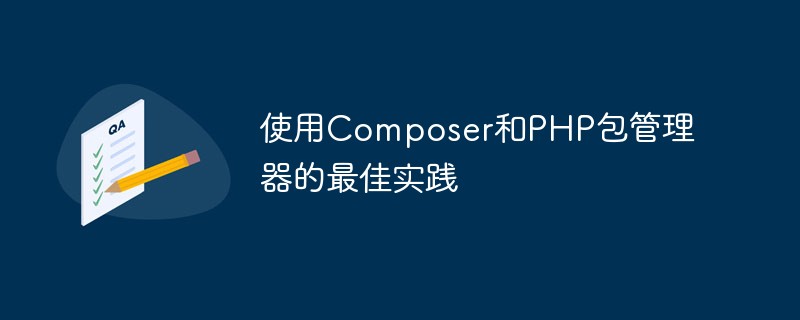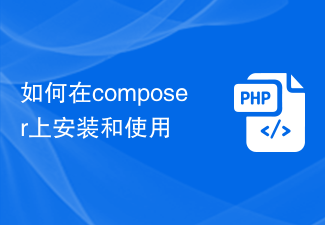The following tutorial column of composer uses will introduce to you the function of composer.lock file. I hope it will be helpful to friends in need!

Basic use of Composer
Use composer.json in the project
Use composer in the project, You need to have a composer.json file. This file is mainly used to declare the relationships between packages and other element tags.
require keyword
The first thing to do in composer.json is to use the require keyword. You will tell composer which packages your project needs
The code is as follows:
{
"require": {
"monolog/monolog": "1.0.*"
}
}As you can see, the require object will map the name of the package (monolog/monolog) and the version of the package is 1.0.*
The naming of the package
Basically, the naming of the package is the main name/project name (monolog/monolog). The main name must be unique, but the name of the project, which is our package, can have the same name, for example: igorw/json, and seldaek /json
Package version
The version of monolog we need to use is 1.0.*, which means that as long as the version is the 1.0 branch, such as 1.0.0, 1.0.2 or 1.0 .99
Two ways of version definition:
1. Standard version: Define a guaranteed version package file, such as: 1.0.2
2. A certain range Version: Use comparison symbols to define the range of valid versions. Valid symbols are >, >=,
3. Wildcard characters: special matching symbols *, for example 1.0.* is equivalent to >=1.0,
4. The next important version: the best explanation of the ~ symbol is that ~1.2 is equivalent to >1.2,< ;2.0, but ~1.2.3 is equivalent to >=1.2.3, Installation package Run in the project file path The code is as follows: In this way, it will automatically download monolog/ monolog file to your vendor directory. The next thing that needs to be explained is composer.lock - lock file After installing all required packages, composer will generate a standard package version The files are in the composer.lock file. This will lock versions of all packages. Use composer.lock (of course together with composer.json) to control the version of your project This is very important. When we use the install command to process it, it will first Determine whether the composer.lock file exists. If it exists, the corresponding version will be downloaded (not based on the configuration in composer.json), which means that anyone who downloads the project will get the same version. If composer.lock does not exist, composer will read the required package and relative version through composer.json, and then create the composer.lock file This way you can After the package has a new version, you will not be automatically updated. To upgrade to the new version, just use the update command. This way you can get the latest version of the package and also update your composer.lock file. Packagist (This should be composer. It feels a bit like a python package, although it is not as powerful. Haha, with this standard, it will definitely be easy for everyone to develop websites in the future, and you can learn from many people’s codes. , and more convenient!) Packagist is the main warehouse of composer. You can check it out. The basis of the composer warehouse is the source code of the package. You can obtain it at will. The purpose of Packagist is to build a library that can be used by anyone. A repository can be used, which means any require package in your file. About automatic loading In order to conveniently load package files, Composer automatically generates a file vendor/autoload.php. You can use it conveniently anywhere you want. Where you need to use This means that you can use third-party code very conveniently. If your project needs to use monlog, you can use it directly, they have been automatically loaded! The code is as follows: Of course you can also load your own code in composer.json: The code is as follows: composer will put psr-0 Register as Acme namespace You can define a mapping through the namespace to the file directory. The src directory is your root directory and vendor is the directory at the same level. For example, a file is: src/Acme/Foo. PHP contains the Acme\Foo class After you add autoload, you must reinstall to generate the vendor/autoload.php file When we reference this file, it will Returns the strength of an autoloader class, so you can put the returned value into a variable and then add more namespaces. This is very convenient if you are in a development environment. For example: The code is as follows: The role of the composer.lock file The install command reads the composer.json file from the current directory, processes the dependencies, and installs it into the vendor directory . code show as below: 如果当前目录下存在 composer.lock 文件,它会从此文件读取依赖版本,而不是根据 composer.json 文件去获取依赖。这确保了该库的每个使用者都能得到相同的依赖版本。 如果没有 composer.lock 文件,composer 将在处理完依赖关系后创建它。 为了获取依赖的最新版本,并且升级 composer.lock 文件,你应该使用 update 命令。 代码如下: 这将解决项目的所有依赖,并将确切的版本号写入 composer.lock。 如果你只是想更新几个包,你可以像这样分别列出它们: 代码如下: 你还可以使用通配符进行批量更新: 代码如下:$ composer install
$ php composer.phar update
或者
$ composer update
require 'vendor/autoload.php';
$log = new Monolog\Logger('name');
$log->pushHandler(new Monolog\Handler\StreamHandler('app.log', Monolog\Logger::WARNING));
$log->addWarning('Foo');
{
"autoload": {
"psr-0": {"Acme": "src/"}
}
}$loader = require 'vendor/autoload.php';
$loader->add('Acme\Test', __DIR__);composer install
composer update
composer update vendor/package vendor/package2
composer update vendor/*
The above is the detailed content of What does the composer.lock file do?. For more information, please follow other related articles on the PHP Chinese website!
 四大步教你在Debian11上安装使用Composer!Nov 08, 2022 pm 04:32 PM
四大步教你在Debian11上安装使用Composer!Nov 08, 2022 pm 04:32 PM本文由composer教程栏目给大家介绍关于在Debian11上是怎么一步步安装,以及使用Composer的 ,非常详细哦~希望对需要的朋友有所帮助!
 Composer是啥Dec 25, 2023 pm 03:06 PM
Composer是啥Dec 25, 2023 pm 03:06 PMComposer是PHP的依赖管理工具,它允许开发者将第三方库和框架与自己的项目进行集成。它的主要功能包括:1、依赖管理;2、版本控制;3、自动加载;4、扩展开发;5、集成其他工具。它简化了PHP项目的依赖管理过程,确保项目的稳定性和可维护性。通过使用Composer,开发者可以更加高效地管理自己的项目和集成第三方库和框架。
 composer 怎么修改php路径Oct 24, 2022 am 11:33 AM
composer 怎么修改php路径Oct 24, 2022 am 11:33 AMcomposer修改php路径的方法:1、搜索“composer.bat”并复制到项目文件夹;2、编辑“composer.bat”,将内容修改为“@ECHO OFF php "%~dp0composer.phar" %*”即可。
 PHP使用Composer安装和管理依赖包Jun 18, 2023 pm 03:30 PM
PHP使用Composer安装和管理依赖包Jun 18, 2023 pm 03:30 PM在PHP开发中,我们经常要处理各种依赖包,这些依赖包可能是其他开发者编写的PHP库文件,也可能是一些第三方工具和框架。为了方便管理这些依赖包,我们可以使用Composer来进行相关的安装和管理工作。Composer是一个开源的PHP依赖管理工具,它可以帮助我们自动化安装、更新和卸载PHP依赖包。通过Composer,我们可以轻松地管理我们应用中的不同依赖,同
 使用Composer和PHP包管理器的最佳实践May 23, 2023 am 08:29 AM
使用Composer和PHP包管理器的最佳实践May 23, 2023 am 08:29 AM随着PHP的日益流行,PHP开发人员面临着许多挑战,其中包括代码管理、可重用性和依赖性管理。这些问题可以使用包管理器来解决,而Composer是PHP最受欢迎的包管理器之一。在本文中,我们将探讨使用Composer和PHP包管理器的最佳实践,从而提高您的PHP开发效率和代码质量。何为Composer?Composer是一款PHP包管理器,它可以轻松管理PHP
 创建composer项目的步骤Feb 19, 2024 pm 07:13 PM
创建composer项目的步骤Feb 19, 2024 pm 07:13 PMComposer是一个PHP的依赖管理工具,可以帮助开发者有效地管理项目中的依赖关系。通过Composer,我们可以轻松地引入第三方库、框架以及其他项目所需的各种资源。创建一个Composer项目非常简单,只需按照以下步骤进行操作:首先需要确保在本地已经安装了Composer。可以在终端中运行composer-v命令来确认是否已经安装成功。在项目的根目录中
 如何在composer上安装和使用Feb 19, 2024 pm 09:38 PM
如何在composer上安装和使用Feb 19, 2024 pm 09:38 PMcomposer是PHP的依赖管理工具,可以方便地安装、更新和管理项目所需的第三方库和依赖。本文将介绍composer的安装与使用,并提供详细的代码示例。一、安装Composer要使用composer,首先需要将其安装到本地开发环境中。以下演示了在Windows系统中安装composer的步骤:打开Composer的官方网站(https://getcompo
 composer动画怎么保存Apr 09, 2024 pm 02:02 PM
composer动画怎么保存Apr 09, 2024 pm 02:02 PM要保存 Composer 动画,可以使用 Lottie 文件格式,具体步骤为:导出为 JSON 文件;使用 Lottie 工具创建 Lottie 文件;从 Lottie 文件导出为多种格式,包括 JSON、GIF、MP4、SWF、HTML。


Hot AI Tools

Undresser.AI Undress
AI-powered app for creating realistic nude photos

AI Clothes Remover
Online AI tool for removing clothes from photos.

Undress AI Tool
Undress images for free

Clothoff.io
AI clothes remover

AI Hentai Generator
Generate AI Hentai for free.

Hot Article

Hot Tools

SublimeText3 Mac version
God-level code editing software (SublimeText3)

Dreamweaver Mac version
Visual web development tools

SublimeText3 Chinese version
Chinese version, very easy to use

VSCode Windows 64-bit Download
A free and powerful IDE editor launched by Microsoft

SublimeText3 Linux new version
SublimeText3 Linux latest version






